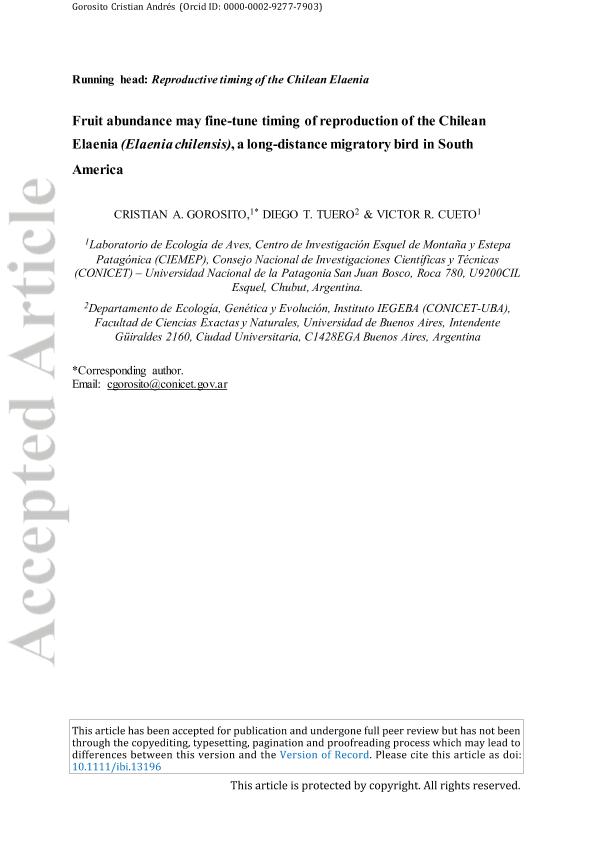Mostrar el registro sencillo del ítem
dc.contributor.author
Gorosito, Cristian Andrés

dc.contributor.author
Tuero, Diego Tomas

dc.contributor.author
Cueto, Víctor

dc.date.available
2023-09-21T15:38:57Z
dc.date.issued
2023-02
dc.identifier.citation
Gorosito, Cristian Andrés; Tuero, Diego Tomas; Cueto, Víctor; Fruit abundance may fine-tune timing of reproduction of the Chilean Elaenia (Elaenia chilensis), a long-distance migratory bird in South America; Wiley Blackwell Publishing, Inc; Ibis; 2023; 2-2023; 1-37
dc.identifier.issn
0019-1019
dc.identifier.uri
http://hdl.handle.net/11336/212545
dc.description.abstract
Timing of reproduction has a great impact on the breeding success of birds because a mismatch with the moment when environmental conditions are warm or when food is most plentiful can reduce nestling survival and increase the energetic cost of parental care. Consequently, birds synchronize gonadal maturation with the most favourable environmental conditions, using photoperiod changes throughout the year as an initial proximal cue. Additionally, non-photic cues, such as temperature and food abundance, may be necessary to fine-tune reproductive timing. However, the influence of non-photic cues on finely tuning reproductive timing is not yet fully understood for migratory birds. Here, we evaluate how much non-photic cues influence the reproductive timing of the Chilean Elaenia Elaenia chilensis, a long-distance migrant that reproduces in the Andean–Patagonian Forest. We assessed associations of mean temperature, ripe fruit and arthropod abundances with the number of nests in the laying period, and also with the number of nests with hatchlings. In both analyses we used cross-correlations and partial least squares path modelling. Mean temperature was not consistently associated with the breeding phenology of Chilean Elaenias. The increase in number of nests in the laying period was preceded by the increase in caterpillar abundance and coincided with the increase in ripe fruit abundance. The timing of nests with hatchlings matched with the timing of highest ripe fruit abundance. Both types of food could contribute to the beginning of reproduction of birds and be used as proximal cues by Chilean Elaenias. Ripe fruits would also be beneficial for nestling growth because parents feed them with fruits, and might potentially play an ultimate role in reproduction. Because ripe fruit abundance was related to the egg-laying and hatching stages, it may be the main cue used by Chilean Elaenias to fine-tune reproductive timing. These findings allow advances in our understanding of the importance of non-photic cues in the reproductive phenology of migratory birds and also generalize our knowledge among regions and taxa, as most studies on this topic focus on the Northern Hemisphere.
dc.format
application/pdf
dc.language.iso
eng
dc.publisher
Wiley Blackwell Publishing, Inc

dc.rights
info:eu-repo/semantics/openAccess
dc.rights.uri
https://creativecommons.org/licenses/by-nc-sa/2.5/ar/
dc.subject
ANDEAN–PATAGONIAN FOREST
dc.subject
CATERPILLARS
dc.subject
FOOD AVAILABILITY HYPOTHESIS
dc.subject
NEOTROPICAL AUSTRAL MIGRANT
dc.subject
NON-PHOTIC CUES
dc.subject
RIPE FRUITS
dc.subject.classification
Zoología, Ornitología, Entomología, Etología

dc.subject.classification
Ciencias Biológicas

dc.subject.classification
CIENCIAS NATURALES Y EXACTAS

dc.title
Fruit abundance may fine-tune timing of reproduction of the Chilean Elaenia (Elaenia chilensis), a long-distance migratory bird in South America
dc.type
info:eu-repo/semantics/article
dc.type
info:ar-repo/semantics/artículo
dc.type
info:eu-repo/semantics/publishedVersion
dc.date.updated
2023-09-15T12:41:59Z
dc.journal.volume
2023
dc.journal.pagination
1-37
dc.journal.pais
Reino Unido

dc.journal.ciudad
Londres
dc.description.fil
Fil: Gorosito, Cristian Andrés. Consejo Nacional de Investigaciones Científicas y Técnicas. Centro Científico Tecnológico Conicet - Patagonia Norte. Centro de Investigación Esquel de Montaña y Estepa Patagóica. Universidad Nacional de la Patagonia "San Juan Bosco". Facultad de Ciencias Naturales - Sede Esquel. Centro de Investigación Esquel de Montaña y Estepa Patagónica; Argentina
dc.description.fil
Fil: Tuero, Diego Tomas. Consejo Nacional de Investigaciones Científicas y Técnicas. Oficina de Coordinación Administrativa Ciudad Universitaria. Instituto de Ecología, Genética y Evolución de Buenos Aires. Universidad de Buenos Aires. Facultad de Ciencias Exactas y Naturales. Instituto de Ecología, Genética y Evolución de Buenos Aires; Argentina
dc.description.fil
Fil: Cueto, Víctor. Consejo Nacional de Investigaciones Científicas y Técnicas. Centro Científico Tecnológico Conicet - Patagonia Norte. Centro de Investigación Esquel de Montaña y Estepa Patagóica. Universidad Nacional de la Patagonia "San Juan Bosco". Facultad de Ciencias Naturales - Sede Esquel. Centro de Investigación Esquel de Montaña y Estepa Patagónica; Argentina
dc.journal.title
Ibis

dc.relation.alternativeid
info:eu-repo/semantics/altIdentifier/url/https://onlinelibrary.wiley.com/doi/10.1111/ibi.13196
dc.relation.alternativeid
info:eu-repo/semantics/altIdentifier/doi/http://dx.doi.org/10.1111/ibi.13196
Archivos asociados
